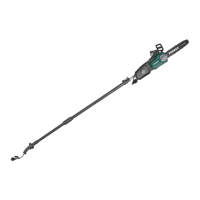machine during its operation.
3. Be aware of the dangerous of operating positions, as well as the risk of being
struck by falling branches or branches that, having hit the ground, rebound,
the operator may be struck by falling branches or by those that rebound
after hitting the ground. Remove the branches in sections.
4. Keep a rm footing and balance during operating. Use the harness
provided.
5. Keep the machine a sucient distance away from overhead electrical power
lines.
SAVE THESE INSTRUCTIONS
Instructions concerning the proper techniques for basic felling,
limbing, and cross-cutting
1. Felling a tree
When bucking and felling operations are being performed by two or more
persons at the same time, the felling operations should be separated from
the bucking operation by a distance of at least twice the height of the tree
being felled. Trees should not be felled in a manner that would endanger
any person, strike any utility line or cause any property damage. If the tree
does make contact with any utility line, the company should be notied
immediately.
The chain saw operator should keep on the uphill side of the terrain as the
tree is likely to roll or slide downhill after it is felled.
An escape path should be planned and cleared as necessary before cuts are
started. The escape path should extend back and diagonally to the rear of
the expected line of fall as illustrated in Figure 1.
Before felling is started, consider the natural lean of the tree, the location of
larger branches and the wind direction to judge which way the tree will fall.
Remove dirt, stones, loose bark, nails, staples and wire from the tree.
2. Notching undercut
Make the notch 1/3 the diameter of the tree, perpendicular to the direction
10

